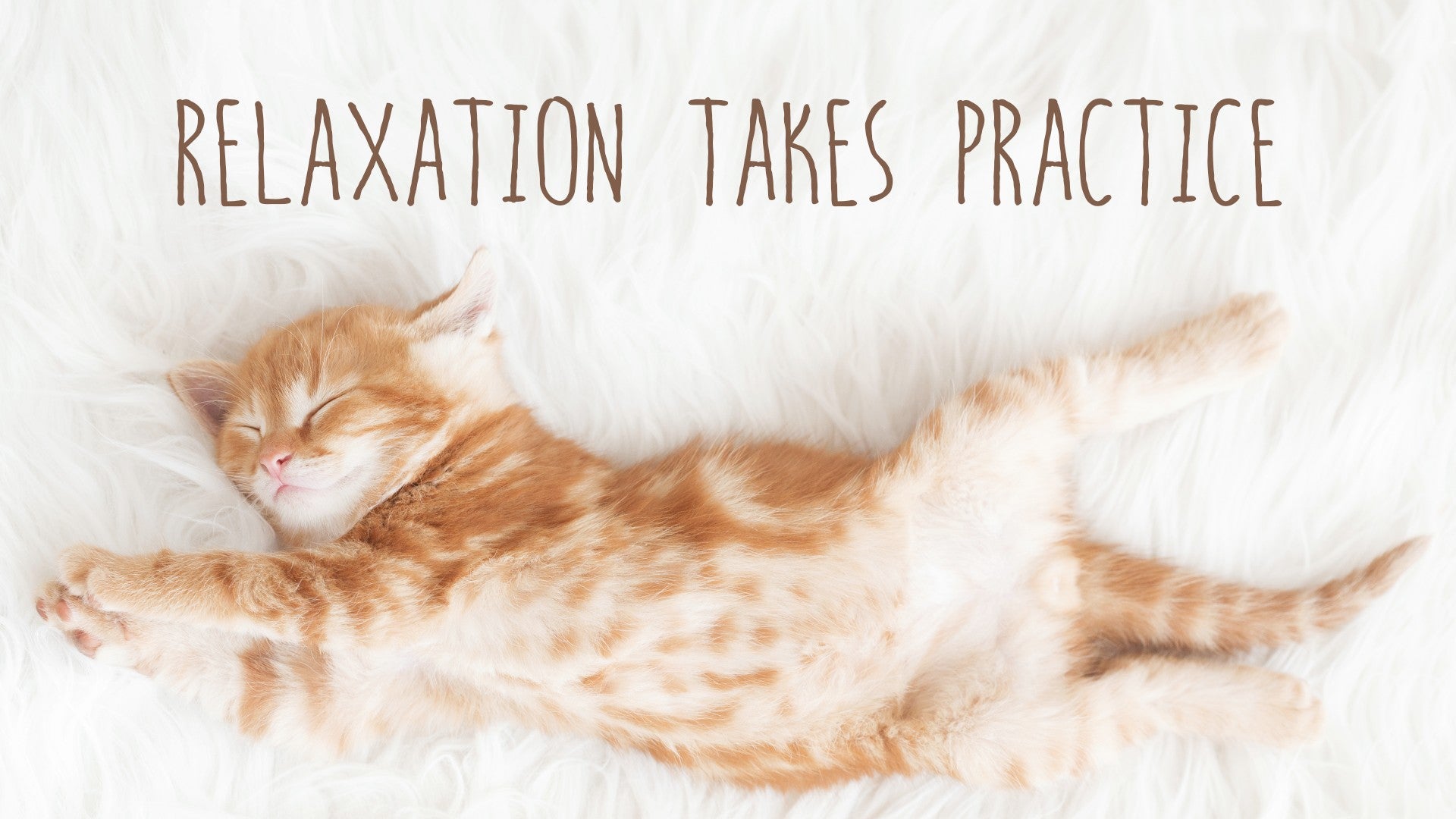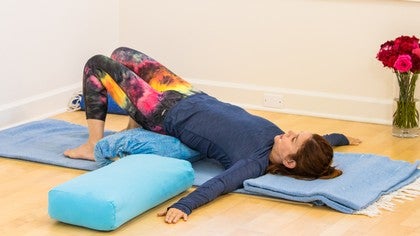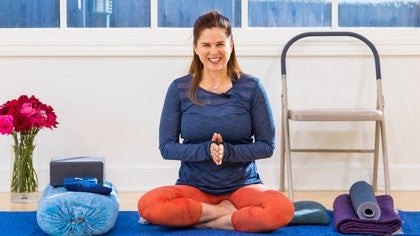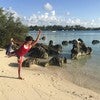Description
About This Video
Transcript
Read Full Transcript
(waves) Hi everyone, thanks for joining me today for Digest and Rest, Restorative Practice. This practice basically helps to improve you digestion. All the poses that are sequenced are aimed at doing that. We're going to need a couple of things. You need three yoga blankets, one to cover your mat to make it nice cushy, a yoga block, a chair, don't worry it doesn't have to be a yoga chair, it can be any chair that you have around the house, also a belt, a block and a if possible, if you're a seasoned practitioner you might have a 10-pound sandbag, if that's the case we'll use it, don't worry if you don't.
Let's get started. The first thing is a downward facing shavasana. What the bolster does, is compress the abdominal area just a little bit, what's great for the digestion is putting a little bit of compression on the abdominal area, a little bit of squeeze, a little bit of turn, a little bit of elongation. So the first one, downward facing shavasana, I've taken a blanket, I folded it one more time from the fourth position one more time in half and I have the clean folded edge facing toward me, my head's gonna rest on top of that. Then I'm gonna take the bolster and bring it right across, in front, maybe about a foot, it really depends on how tall you are, how short you are but this is about where it is, about a foot away from the edge of the blanket.
Now I'm gonna use this 10-pound sandbag. It's kinda a little way to get into it but I wanted to show it because it really does make this pose very very comfortable. I'm gonna start with my legs like this and then kneeling almost like a child pose position and place the support on my lower back, lean forward til I can catch the weight and then I'm gonna crawl myself forward, slide my legs, until I can get the center of my pelvis right on the bolster then I'm gonna take this blanket, slide it forward just a little bit to accommodate for my stretch and then release my head down, bring my elbows and forearms out to the sides. I'm gonna turn my toes in and totally relax the weight of my pelvis into the floor. Now it's okay not to use the blanket.
It's also okay to turn your head to the side. Whatever feels most comfortable. Let's everybody take a full inhale. When you exhale let the weight of belly fall right down into the bolster. So every exhalation, maybe three breathes after one another so see if you can soften that weight of the belly into the support and let that chest totally sink into the floor.
You may find that the more you do that you need less and less support underneath your head. I'm gonna actually move this blanket a little bit, come all the way down on the ground. Let's stay now for three minutes. With the weight of that exhalation and the feeling of that air releasing, I let the belly totally drop and surrender. Any tightness in the abdominal area, any congestion, I let the exhalation just pour it all out.
And every now and then you might feel like just taking a deeper inhale and a deeper exhale and letting the bolster receive the weight of the belly and letting the floor receive the weight of the chest. If your head was turned in one direction you may decide to turn it in the other direction now. Let's follow the next three breathes. This time pay attention to the inhalation as well. The way that the abdomen pulls up and away, from gravity and exhale releases back into it.
And if your head is turned to the side, now you can tuck the chin and bring your head back to the center. We're actually gonna reach back and pull the bag away from us, and just let it slide to the side. Then we're gonna stretch the right arm out in front of us. Bend the left elbow, bring the left palm flat to the floor. Roll to the right, lean over to your right hip and draw the left knee all the way up into the bolster.
Let the head rest in the upper right arm and just be in this sort of floppy supported fetal position. Pausing, letting go, feeling the effects of what you've just done. Then go ahead and slide your palm so it's closer to your chest. Bend your right leg, push through your hands, slide your leg up off the bolster and just come into a regular seated position any comfortable seated position is fine. Bring your hands down to your legs, close your eyes and let's pause together.
Now that you're upright again and the belly is free, maybe take a big breathe into it. And the gently open the eyes, we'll prepare for the next pose which is ustrasana, camel pose, it's done with a chair. We need a bolster, we need the chair and a block and that's it, so I'm gonna move the bolster so that it's parallel. I'm gonna keep this other blanket at the end of my mat and position the bolster so it's parallel to your mat. Go ahead and get your block and your chair.
Bring it over to your other end of the mat and I'm gonna place the block on its long thin side. It's the medium level and you can always change the position if you need to for head support. I'm gonna bring the bolster kinda close toward the chair and then just straddle it. I'm actually sitting on top of the bolster. The sandbag we're gonna push to the side.
I'm gonna bring the chair a little closer toward me so that I can feel that it's almost touching my back. Place the hands on the front legs of the chair, push down with your hands to get some leverage to lift you chest 'cause you're going into a back bend and then right when you feel that lip of the chair hit right between your shoulder blades, you're in a pretty good position. You could lift the chest a little bit more and then slowly release the hands to hold onto the block and position it where you go, okay that feels good, I like that. I'm sliding my pelvis forward just a little bit to give my lower back a little more room and then you can go ahead and hold onto the back of the chair with your hands. So you can determine if you want less stretch in the chest and shoulders, hands go higher or if you pull them apart a lot more you'll get more stretch in that area.
Let's close the eyes again. Feel that elongation that we have in the abdominal area now and let's stay here for three minutes. I just breathe into that soft open merciful belly. And maybe you start with your arms way out to the sides. You can always change them, you can hold your hands on the underside of the chair, or the backside of the chair.
Just explore and see what feels good. And the feeling good part is knowing that you can be there for a while. That doesn't create pain, doesn't induce fear and sets you in that place of letting go of any tension you may have been building before this. You can also release the hands all the way down, let them rest on your thighs, if you wish to avoid any sensation at all. Remember that you can change the level of the block to accommodate for any opening that you may feel now in your neck.
Now let's really focus on that abdominal region. The length that you have, the lowest part of the lower belly letting it spread and open softly with an inhale and settle and relax on an exhale. Let's notice the breathe that we're taking right now. Bring your awareness down to the belly one more time. On an exhalation, let a soft sound come out as if it were coming up from the belly.
Inhaling (releases breathe), good. Open your eyes gently, release your arms. You can use one hand underneath your skull if you want some additional help to bring the head more into a neutral position but then bring your hands back down to the floor, tuck the chin just a little, press with your hands and lift with the chest to come into a neutral seat position. Bring your hands anywhere you like. Close the eyes and pause.
Then gently open your eyes. Now let's prepare for the next pose. We're headed toward parvita poving mutosina and it's basically a prone twist on the belly. All we need for it is the bolster. I'm gonna move the rest of the props outta the way.
And we're gonna start by bringing our right hip to the short end of the bolster and right in the middle. Your legs can be bent like this or they can be stretched out, whatever feels comfortable for you. Bring your hands on either side of the bolster. Lift through your spine on an inhalation. When you exhale, really initiate that turn from the left lower belly.
Maybe do it a couple of times on an exhale. Trying to inform that left side of the navel to move all the way toward the right mid-thigh. What you want is to try to guide the left side of the chest faster to the bolster than the right side. Elbows, forearms and hands can be on either side of the support and for ease of the neck just turn your head to the left so it's facing the same direction as the knees. If you want more rotation in your neck, turn your head in the opposite direction away from the knees.
Let's pause here and be here for about two minutes. Close the eyes. We have this very soft little turn on the belly, it's a ringing out twist. As I begin to settle into the pose a little more I just kinda notice my habits. You might notice yours as well.
One of mine is to pull on my shoulders to close to my ears. So I'm gonna make that adjustment now by fanning my elbows out a little. Settling myself a little more onto the support so I can let go. Let's take the next three breathes together. With each exhalation, soft on that left side of the belly a little more, let the right side of the belly sink into the support.
Now if your head is turned away from the knees, go ahead and tuck your chin and turn it back in the direction of the knees. And then to come out we're just gonna slide our palms down underneath the shoulders. Just tuck the chin a little bit. Our head's gonna be the last thing that comes up. So pressing the palms, start to lift the chest, the belly will come away and the head and return to a comfortable seated position.
Pause, notice what you feel. I let the feeling go. And then open the eyes and we'll prepare for the opposite side. It's really simple, all we have to do is just swivel our hips in the opposite direction. So instead of the right hip, we'll turn so that the left hip comes very close to the edge of the bolster.
Then the legs like you did before or try a different position if you like. Bring the hands on either side, take an inhale of the spine. When you exhale move that right side of the belly toward the left mid-thigh, do it again. And then slowly begin to guide that right side of the chest a little faster to the support than the left side. With the elbows and forearms and hands come on either side of the support.
Either turn your head in the direction of the knees for less rotation of the neck or more, look away. When you exhale, soften the weight of that belly. The beauty about these restorative poses is there's no need to try to achieve anything. The pose has already set up the alignment for you by the way that we've positioned the props. So really all that's necessary is your utter presence and your interest in the breathe and letting go.
Let's stay these two minutes now. I notice my shoulder habit starting to creep up, so I make the adjustment to accommodate. That always elicits a deep breathe in me after I've done that. Let's take the next three breathes together and as you exhale let that left side of the belly soften toward the right side and let that right side of the belly, drop and melt into the support beneath you. If your head is turned away from the knees go ahead and tuck it now and turn it in the direction of the knees.
Slide your palms down underneath the shoulders. Inhale to push your arms to straight position. Pause a moment and then come sit in a comfortable seated position again, letting your hands rest somewhere around your legs. Close the eyes, feel the effects of the twists on the body and the mind. Then gently open the eyes.
We're gonna move into a pose called arda apanasa. It's basically one or half, really half leg into the chest and we're gonna be using a belt and a sandbag if you have it. I'm also gonna use this other blanket that's at the top end of my mat for my head. You may find that you don't wanna use it. You can push it outta the way or you can make it thicker than I'm gonna make mine for more support.
So since we no longer need the bolster I'm gonna move that out of the way. And then I'm going to take the sandbag, if you have it, it's great. I do wanna say that sometimes you can just use a 10-pound of rice, that'll work too. The belt, and then also the blanket at the top. I'm unfolding it now in the original fold that I had.
My head's gonna go here. We're gonna take the belt, unwind it and we're gonna fastened it, and I have a d-ring belt which means that I have metal pieces instead of the plastic fastener but it doesn't matter what kinda belt you have. I place the end of it through both of the metal pieces and separate them and then pull the other end through it. Now, I would make the belt pretty long and that way we can adjust it. The thing that you're gonna want to make sure you have in place, is this tail.
You want it to be moving so that it's away from you, rather than up towards you. So what I'm gonna do is stretch my legs out in front of me. I'm gonna work with the left leg, coming in toward the chest first. So I'm gonna draw the belt so that the tail is going to the left, I'm gonna place one end of the loop around my right foot, bend my left leg and bring the other loop around the top of the thigh. I'm gonna cinch it in a little bit just so it gets a lot tight.
Slide my body forward a little bit and then start to come down on my back. Right now I can place this bag on top of the right thigh, that's really nice to ground your lower back and pelvis. Then I'm gonna bend my straightness out a little bit. I'm gonna bend the left leg, pull on that belt on the tail end just a little so that it's gotten a little tighter. You don't want it too tight that you can't bring the leg all the way in.
Now I can lower my head, adjust that blanket, bring that belt so it comes right to the thigh crease, loosely interlace my fingers, either around the shin below the knee or between the calf and hamstring, whichever you like. Now I want you to know that I'm not pulling on the leg. Once the leg goes in to where it naturally wants to go in, I'm just holding it in place that's all. The belt does a lot of this for you. So you don't have to worry about drawing the leg in anymore, relax the shoulders, soften the weight of the body.
Let's be here for two full minutes. And right where that contraction is on the left side of the lower belly, I'm gonna just soften it on the exhale and let that left thigh relax ever more in toward my torso but not by pulling with my hands. I'm inviting you to do the same, each time you take an inhale, feel how that leg naturally draws away from you. When you exhale feel how the leg naturally draws in towards you. Let the belly soften, catch the weight in your hands.
If you're feeling any sensation that's uncomfortable in you lower back, you could always bend the right knee a little bit and tighten the belt to accommodate that option. Let's notice the breathe that we're taking and take three more together. And then, very gently on your next exhalation release your hands from the leg, go ahead and slide that bag off to the side, straighten the left leg, let your arms comes out and just pause. And then gently bend the left knee, take your leg out of the belt. Your foot can stay in the belt if you want.
You're just gonna roll to the right, right now. Pause. And then let's prepare for the other side. So go ahead and push and come up. Just like we did before, we'll straighten the legs out in front of us.
We're gonna move that belt so now it's coming to the side. We're gonna take the other end of the belt and bring it around the left foot. We're gonna move the bag over the left side. Then the right leg, catch the belt around the top of the thigh. Slowly start to lower.
Don't forget about that bag if you have it. Place it right on the top of the left thigh. I'm just going to adjust so that belts right around the heel and then start to bring it in. Right about here I sorta test it to see. I'm gonna loosen this up just a little.
And that's where I kinda go. You'll find the right place, where does that leg wanna go before it feels like you have to start doing something to bring it in and then once I find that, adjust the skull if you have a blanket underneath you, gently interlace those fingers, either on the top of that leg or between the upper and lower leg and then soften the shoulders. And by the way, this foot of the bent leg, it's soft, it's passive, you don't have to push it forward. And now let's stay these two minutes together. And let that inhalation come in right where I feel that belly being contracted and deliberately soften that right side of the belly as that leg naturally wants to come in.
I refrain from pulling on the leg. We're trying to do more. Now just allow yourself to be satisfied with what's happening now. Let's take the next three breathes together, focusing on getting that right side of the belly to soften through the exhalation. And on your next exhalation, go ahead and release the hands, let the foot come flat to the floor.
You can slide that bag off if you've got it, just let it roll to the side and then go ahead to stretch that right leg all the way out. Let your body be really passive, really dormant, really relaxed and still. Breathe into the new opening you may have in the belly. Especially now that both of the legs are stretched out again and then we're gonna bend the left knee, set that food flat, bring your left arm in towards your chest and roll over to that right side in that fetal position and just pause when you get there. And gently open the eyes and slowly push to come up.
So headed to the final pose shavasana and we're gonna get rid of some props and bring some others back over to the mat. We're gonna let go of the belt. So we can go ahead and rill that up, put that to the side. Then we're gonna bring over the bolster and if you do have a sandbag, go ahead and bring that over as well. I'm gonna keep this for my head and use it because I like it (laughs) and I'm gonna place the bolster, you have two options, one would be to place the bolster right on top of the thighs because we are doing something for Rest and Digest.
Rest would be more here, digest would be more at the belly. So you decide what you think you might like. Try both and see, I like this one or I like that one. If I put the bolster on the tops of the thighs and then put the bag there, that releases the weight of my pelvis into the floor. Feels really good.
If I wanna have a little more of that abdominal stimulation, I set the bolster actually on the belly and then of course, I put the support of the bag on top of that. I like that one too (laughs). It really just depends on what you want. You can go back and forth. I'm gonna suggest start here and then maybe after two minutes I'll invite you to slide it down if you do have it at the belly.
So let's try that. Let's get the arms out. Let the feet go limp and relaxed, the limbs, all settle into gravity. Wherever your bolster is, take a slow deep inhale. Feel your body push that support away as you exhale welcome the support, let it sink into you and let your body sink into gravity.
Let's begin the first few minutes and then we'll trail off into about a five minute shavasana. So the invitation to slide the bolster away from the belly to you legs is now. Feel free to do that. If you've done that, take a soft breathe into that merciful belly. And continue to relax.
And gently bring your awareness back to the belly and feel the breathe moving the belly with each inhale and exhale. And gently rub you thumb and index fingers up against one another. And before we come to sit up, we're gonna bend the elbows and just let your hands rest very gently at the belly. Imagine that you have an inner smile that lives in you and today you're connect with it living here at the belly. Feel the feeling that arise in you as you connect with this inner smile here.
Hold lightly to the feelings. Begin to pull the sandbag off of your support. Go ahead and remove the bolster as well. Bend the left knee, set that foot flat on the floor, left arm in toward the chest and roll to the right side of the body. Happy belly, happy mind.
And lean your chest into the floor, press with your left palm to come up into a comfortable seated position. Join your palms at your chest again. Thank you for practicing with me today. Be happy (foreign language).
Relaxation Takes Practice
Comments
again a wonderful practice. Can you please say a little bit more about the "half leg into the chest" pose? What is the effect? Why do you use the strap in this way? How tight should the strap be? Sorry, for so meany questions and thank you.
Silke
You did a great job getting the pace just right as it does take me some time to get my props in the most appropriate place sometimes!
Many thanks.
kim
You need to be a subscriber to post a comment.
Please Log In or Create an Account to start your free trial.















